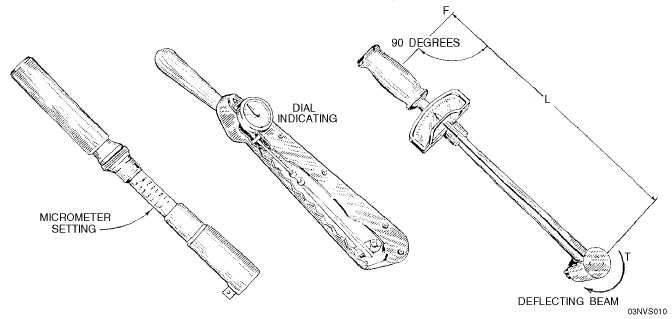The three most commonly used torque wrenches
are the deflecting beam, dial indicating, and
micrometer setting types (fig. 1-34). When using the
deflecting beam and the dial indicating torque
wrenches, read the torque visually on a dial or scale
mounted on the handle of the wrench.
To use the micrometer setting type, unlock the grip
and adjust the handle to the desired setting on the
micrometer-type scale, then relock the grip. Install the
required socket or adapter to the square drive of the
handle. Place the wrench assembly on the nut or bolt
and pull in a clockwise direction with a smooth, steady
motion. (A fast or jerky motion will result in an
improperly torqued unit.) When the torque applied
reaches the torque value, which is indicated on the
handle setting, a signal mechanism will automatically
issue an audible click, and the handle will release or
"break," and move freely for a short distance. The
release and free travel is easily felt, so there is no doubt
about when the torquing process is complete.
Manufacturers' and technical manuals generally
specify the amount of torque to the applied. To assure
getting the correct amount of torque on the fasteners, it
is important that the wrench be used properly according
to manufacturer's instructions.
Use the torque wrench that will read about
mid-range for the amount of torque to be applied. BE
SURE
THE
TORQUE
WRENCH
HAS
BEEN
CALIBRATED BEFORE YOU USE IT. Remember,
too, that the accuracy of torque-measuring depends a
lot on how the threads are cut and the cleanliness of the
threads. Make sure you inspect and clean the threads. If
the manufacturer specifies a thread lubricant, it must be
used to obtain the most accurate torque reading. When
using the deflecting beam or dial indicating wrenches,
hold the torque at the desired value until the reading is
steady.
Torque wrenches are delicate and expensive tools.
The following precautions should be observed when
using them:
1.
When using the micrometer setting type, do not
move the setting handle below the lowest
torque setting. However, it should be placed at
its lowest setting before it is returned to
storage.
2.
Do not use the torque wrench to apply greater
amounts of torque than its rated capacity.
3.
Do not use the torque wrench to loosen bolts
that have been previously tightened.
4.
Do not drop the wrench. If a torque wrench is
dropped, its accuracy will be affected.
5.
Do not apply a torque wrench to a nut that has
been tightened. Back off the nut one turn with a
nontorque wrench and retighten to the correct
torque with the indicating torque wrench.
6.
Calibration intervals have been established for
all torque tools used in the Navy. When a tool is
calibrated by a qualified calibration activity at
a shipyard, tender, or repair ship, a label
showing the next calibration due date is
attached to the handle. This date should be
checked before a torque tool is used to ensure
that it is not overdue for calibration.
1-24
Figure 1-34.—Torque wrenches.

